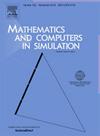An innovative methodology in scrutinizing the nonlinear instability of two immiscible MHD viscoelastic liquids
IF 4.4
2区 数学
Q1 COMPUTER SCIENCE, INTERDISCIPLINARY APPLICATIONS
引用次数: 0
Abstract
This study examines the nonlinear stability of two distinct viscoelastic magneto-rheological planner fluids that are immersed in porous media. The lower zone is filled with the Reiner-Rivlin fluid (RRF); meanwhile, the upper one is occupied by the Eyring-Powell fluid (EPF). An unchanged magnetic field (MF) is applied to the whole structure, and the effects of surface tension (ST) and mass and heat transfer (MHT) are also documented. This approach offers insights into stability thresholds and flow dynamics crucial for applications in energy systems, medicinal devices, and industrial processes that involve multi-layered magneto-rheological fluids in porous settings. One use of these fluids is the real-time adjustment of damping qualities in adaptive vehicle suspension systems. Improvements in vehicle dynamic performance, comfort, and safety are directly impacted by this research. The calculations are shortened by making use of viscous potential theory (VPT). Therefore, the viscoelastic influences are considered in order to show how the nonlinear boundary conditions (BCs) produce their contributions. Consequently, the impacts of the viscoelasticity parameters are removed from the solution of the equations of motion. Merging the fundamental linear hydrodynamic equations with Maxwell's equations over the quasi-static approximations, the boundary-value problem is raised. A popular nonlinear ordinary differential equation (ODE) can be transformed into a linear via the He’s frequency formula (HFF), which forms the basis of the non-perturbative approach (NPA). The non-dimensional analysis reveals a set of physical dimensionless numerals. Additionally, they help to reduce the amount of variables that are needed to comprehend the framework. The stability constraints are numerically tested in the complex scenario, and the stability mechanism remains consistent for both real and imaginary coefficients within the nonlinear characteristic equation governing interface displacement. Polar plots of unstable solutions are omitted, since these solutions are not desired.
研究两种不混相MHD粘弹性液体非线性不稳定性的创新方法
本研究考察了浸泡在多孔介质中的两种不同粘弹性磁流变规划液的非线性稳定性。下部区域充满Reiner-Rivlin流体(RRF);上部为EPF流体(Eyring-Powell fluid)所占据。在整个结构上施加不变的磁场(MF),并记录了表面张力(ST)和质量传热(MHT)的影响。这种方法为能源系统、医疗设备和工业过程中涉及多孔环境中的多层磁流变流体的应用提供了稳定阈值和流动动力学的见解。这些液体的一个用途是实时调整自适应车辆悬架系统的阻尼特性。该研究直接影响到车辆动态性能、舒适性和安全性的提高。利用粘性势理论(VPT)缩短了计算时间。因此,考虑粘弹性影响,以显示非线性边界条件(bc)如何产生它们的贡献。因此,从运动方程的解中消除了粘弹性参数的影响。将基本的线性流体力学方程与麦克斯韦方程组合并在准静态近似上,提出了边值问题。一个常见的非线性常微分方程(ODE)可以通过He’s频率公式(HFF)转化为线性方程,它构成了非摄动方法(NPA)的基础。无量纲分析揭示了一组物理上的无量纲数字。此外,它们有助于减少理解框架所需的变量数量。在复杂情况下对稳定性约束进行了数值验证,在控制界面位移的非线性特征方程中,实系数和虚系数的稳定性机制是一致的。不稳定溶液的极坐标图被省略,因为这些溶液是不需要的。
本文章由计算机程序翻译,如有差异,请以英文原文为准。
求助全文
约1分钟内获得全文
求助全文
来源期刊

Mathematics and Computers in Simulation
数学-计算机:跨学科应用
CiteScore
8.90
自引率
4.30%
发文量
335
审稿时长
54 days
期刊介绍:
The aim of the journal is to provide an international forum for the dissemination of up-to-date information in the fields of the mathematics and computers, in particular (but not exclusively) as they apply to the dynamics of systems, their simulation and scientific computation in general. Published material ranges from short, concise research papers to more general tutorial articles.
Mathematics and Computers in Simulation, published monthly, is the official organ of IMACS, the International Association for Mathematics and Computers in Simulation (Formerly AICA). This Association, founded in 1955 and legally incorporated in 1956 is a member of FIACC (the Five International Associations Coordinating Committee), together with IFIP, IFAV, IFORS and IMEKO.
Topics covered by the journal include mathematical tools in:
•The foundations of systems modelling
•Numerical analysis and the development of algorithms for simulation
They also include considerations about computer hardware for simulation and about special software and compilers.
The journal also publishes articles concerned with specific applications of modelling and simulation in science and engineering, with relevant applied mathematics, the general philosophy of systems simulation, and their impact on disciplinary and interdisciplinary research.
The journal includes a Book Review section -- and a "News on IMACS" section that contains a Calendar of future Conferences/Events and other information about the Association.
 求助内容:
求助内容: 应助结果提醒方式:
应助结果提醒方式:


